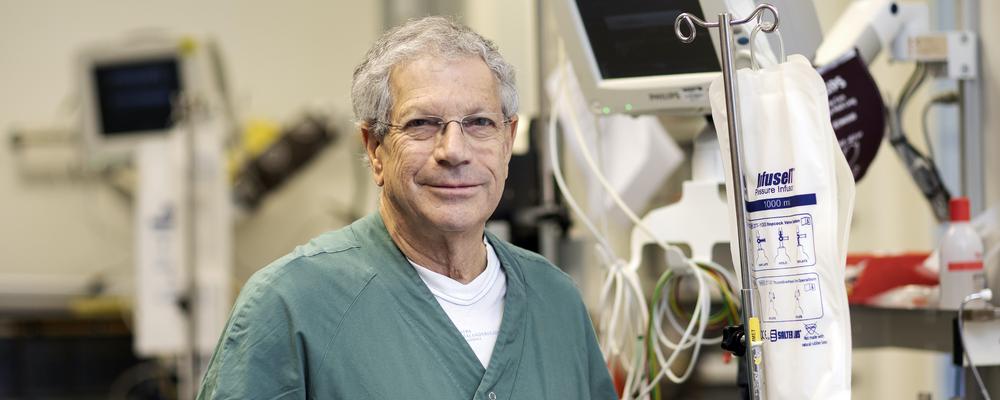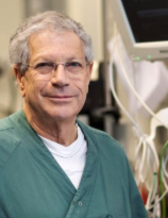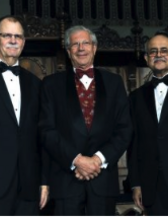
- Hem
- Forskning
- Hitta forskning
- Roles and duties in war and peace in focus for visiting professor Boffard
Roles and duties in war and peace in focus for visiting professor Boffard
VISITING PROFESSOR. During one of Kenneth Boffard’s first assignments, as a doctor in Europe, at a hospital in Birmingham, he had to manage the casualties of an IRA bombing. Some 40 years later, as Visiting Professor at Sahlgrenska Academy he is working with members of the Department of Surgery to develop a training program that meets the needs of health professionals working in crisis and war-torn countries abroad. We have met the recognized trauma expert Professor Kenneth (“Ken”) Boffard for an interview.

Ken Boffard from South Africa was appointed Visiting Professor at Sahlgrenska Academy in 2016. His career has been dedicated to developing life-saving trauma surgical practice and associated academic study programs, and his work is acknowledged the world over. In October he became one of only two non-Americans awarded full membership of the ACS Academy of Master Surgeon Educators.

Boffard’s other titles include Professor Emeritus at the University of the Witwatersrand and Honorary Consultant in its Department of Surgery, and Academic Head of Trauma Surgery at the Milpark Hospital in Johannesburg, South Africa, one of the University’s Academic Teaching Centers. The ACS Academy Award is, of course, a prestigious award, and he has received several other awards over the years for his commitment and his outstanding knowledge in the field of trauma surgery, intensive care, and related study programs.
His ambition to educate and impart knowledge has resulted in the creation of the world’s most advanced open surgical training course, Definitive Surgical Trauma Care (DSTC), now held in seven languages, in 33 countries. These include Sweden, which had one of the first established programs. The course has culminated in a book entitled Manual of Definitive Surgical Trauma Care, sold worldwide and now in its fifth edition.
Boffard is also one of the pioneers of EMS (Emergency Medical Services) helicopters in South Africa. These flying intensive care units, widely used in Sweden too, are an essential resource in pre-hospital management of critically injured patients, and vital in saving lives daily. Evidently, he is highly deserving of this award,of course, a prestigious award, and he has received several other awards over the years for his commitment and his outstanding knowledge in the field of trauma surgery, intensive care, and related study programs.
His ambition to educate and impart knowledge has resulted in the creation of the world’s most advanced open surgical training course, Definitive Surgical Trauma Care (DSTC), now held in seven languages, in 33 countries. These include Sweden, which had one of the first established programs. The course has culminated in a book entitled Manual of Definitive Surgical Trauma Care, sold worldwide and now in its fifth edition.
Boffard is also one of the pioneers of EMS (Emergency Medical Services) helicopters in South Africa. These flying intensive care units, widely used in Sweden too, are an essential resource in pre-hospital management of critically injured patients, and vital in saving lives daily. Evidently, he is highly deserving of this award.
Longstanding relationship with Sweden
“For many years, we’ve had doctors from Sweden, mostly Gothenburg, coming to us at the hospital in Johannesburg to train and practice in trauma care. This is because, although you have good doctors in Sweden, they don’t usually have much experience of trauma surgery. After all, yours is a country at peace, a safe one — or, at least, it has been,” Boffard says.
Adjunct Professor Per Örtenwall at Sahlgrenska Academy, one of the doctors who visited Johannesburg, was instrumental in introducing the DSTC course in Sweden. Jointly with Ken Boffard, he developed a course for doctors working in peaceful areas as civilians, but in the Armed Services. Since 2006, Boffard has spent one week a year in Sweden teaching these courses.
“Even if you’re a skilled breast surgeon, for instance, and end up with a multitrauma, a gunshot wound, or injuries from a terrorist act, at the accident and emergency department, you don’t know enough to handle the situation optimally. You’re out of your comfort zone,” Boffard says.
Threat scenario in Sweden increasing
In 2015, Adjunct Professor Hans Lönroth at Sahlgrenska Academy, Head of Area 5 at Sahlgrenska University Hospital, invited him to move to Sweden for a longer period, as a visiting professor. This was because the country’s threat situation was deteriorating and the need for advanced trauma care beginning to increase. This need is still growing: In 2018, 148 patients with gunshot wounds were admitted to Swedish hospitals. (The figure excludes those who died before reaching hospital.) In the same year, there were some 40 incidents involving hand grenades (see BBC News, Sweden’s deadly problem with hand grenades). There have been more than 30 explosions in the past two months and 100 this year, 13 of which were in Gothenburg.
“Ken Boffard is a well-qualified external reviewer who’s helping to increase our knowledge of trauma care. Together, we’ve now started to build networks in the region to boost motivation and develop pre-hospital management of critically injured people. It’s very important for the healthcare services and politicians now to recognize the growing need for trauma care, and take it seriously,” Lönroth says.
“We also want to strengthen our academic work for multitrauma patients and our society’s provision for them. The knowledge we’re now building with Professor Boffard will also affect care of the large category of patients who suffer from multitrauma due to severe traffic and fall accidents, for example. In other words, society will benefit greatly if we can help more survivors return to work,” Lönroth continues.
Patients, teachers and resources essential
Since 2016, Ken Boffard has been visiting Sweden regularly, working in the Department of Surgery at Sahlgrenska University Hospital and teaching the doctors there, and engaged in education and research at Sahlgrenska Academy as well. He also supervises PhD students, Linda Sonesson at Karolinska Institute being among the first to complete her doctoral thesis in 2018.
“You need patients, teachers and resources to be able to develop your skills. I’ve got a lot of experience from the three university hospitals I work with in Johannesburg,” Boffard says.
“For instance, the biggest of the three admits 500 monthly of the most severely injured patients (‘Priority 1 patients’), who have life-threatening injuries needing care within five minutes of arrival. By comparison, Sahlgrenska University Hospital admits 40 patients a month in this category.”
It started with bombs and blast damage in Birmingham
Growing up in a doctor’s family (his father was a gynecologist), Boffard realized early on that he wanted to be a surgeon. Initially, he worked as a part-time firefighter and driving instructor during his university studies, to get by financially and pay the tuition fees. After qualifying as a doctor, he went backpacking in Europe. In England, he asked a friend living in Birmingham whether they needed doctors at the hospital.
“In 1844 they built the new Queen’s Hospital in Birmingham. It happened to be next door to the biggest brewery in the city. The brewers went to the hospital and said, ‘We see a lot of injuries: If we give you free beer, will you treat our injuries for free?’ ‘Sure,’ the hospital replied,” Ken Boffard says with a smile.
In 1944, Britain was preparing to invade and liberate the Netherlands, and expecting many casualties. The military went and told this hospital they were going to turn it into a trauma hospital. The hospital had no other option — and it did have some previous experience from injuries occurring in a brewery, for what it was worth. So, it became the world’s first trauma hospital.
“Then in 1974 I went to that hospital and asked for a job, and they said ‘Yes, sure!’ And you know what? The beer tap was still there, and in use! So we could always have a drink before going in to surgery, just as they did in World War Two,” Ken said, laughing and winking.
Three months later, the IRA bombed Birmingham. This was the first time they had bombed the British mainland.
“After the first bomb, we admitted 120 casualties in 10 minutes. And we managed it pretty well, actually. I was the most junior of the juniors, but that didn’t deter me. On the contrary, it started my interest in trauma surgery and care.”
Since then, Boffard has received a great deal of training himself and educated others around the world, both clinically and in trauma management, in times of both war and peace.
Sweden needs people like Ken Boffard
“The Swedish military has a problem: They don’t have enough trauma-trained doctors to meet the potentially extended threat and peace-keeping picture facing Sweden today. Another, connected problem is the shortage of hospital staff, which means that doctors can’t get time off for education and to get the necessary training. So, we’ve been trying to find more effective ways to teach,” Boffard says.
At Imperial College London, a computerized, AI-based study program is now being developed for surgeons.
“With limited time for training, a computer-based program reduces the gaps between education, mindset and skills, and more surgeons can therefore be trauma-trained.”
Courses in austere conditions to help health professionals abroad
In humanitarian terms, Sweden is one of the best countries in the world. For the coming year, his last as visiting professor, Boffard will be working with other Department members to develop a training program that meets the needs of health professionals working in crisis and war-torn countries abroad. The course is unusual; many courses in surgical management under adverse conditions are available, but none are designed to change the participants’ mindsets.
“We call this program or course Austere Conditions, as in just having the absolute necessities when you live with severely limited money, goods and also resources. The course works in humanitarian interventions, as well as in military peacekeeping situations and war. It focuses on situations not involving actual healthcare but relating to daily life, such as what to do when the water runs out, there are power cuts, and so on. This is a part of non-operative management (NOM).”
In Boffard’s view, knowledge and skills of this kind can benefit Sweden and Sahlgrenska University Hospital in crises other than in wartime, such as natural disasters and terrorism.
Others to continue his work
In 2020, when Ken Boffard returns to his home in Johannesburg, other people will carry on his work in Sweden. He mentions three highly competent colleagues: Adjunct Professors Per Örtenwall and Hans Lönroth of Sahlgrenska Academy (next year, the latter will leave his position as Head of Area 5 at Sahlgrenska University Hospital), and Ragnar Agn, head of the trauma unit at Sahlgrenska University Hospital.
Sweden has led the world in disaster management, he says. He mentions Amir Khorram-Manesh, one of Sahlgrenska Academy’s experts in disaster management, and Sten Lennqvist of Linköping University, who pioneered trauma practical training and disaster medicine preparation in Sweden. He also refers to the “LIFE” disaster practice in April last year, which Karolinska University Hospital turned down, saying it was too difficult.
“Then the military chose us, and we succeeded extremely well. And now there’s the new ‘Disaster Medicine Knowledge Center West’, with the surgeon Yohan Robinson in charge. Yohan is also well connected in the military world and a highly competent person. The center combines regular healthcare and the military kind, and will play an important part in the development of trauma care in West Sweden and nationwide.”
Finally, Boffard addresses an area in which, in his opinion, the University of Gothenburg needs to improve: its training in trauma care for medical students. The need for this kind of knowledge has increased. The University must take this seriously, and it will take time.
TEXT: SUSANNE LJ WESTERGREN
PORTRAIT PHOTO: JOHAN WINGBORG